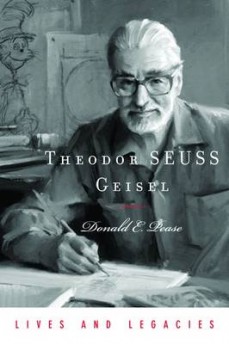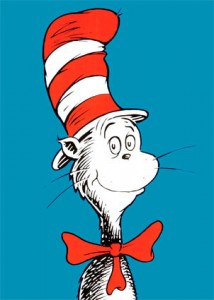This month marks the 106th anniversary of Dr. Seuss’ birth and, with it, the publication of Theodor SEUSS Geisel by Donald E. Pease, Professor of English and the Avalon Foundation Chair of the Humanities at Dartmouth College. I studied with Professor Pease, a renowned scholar of American literature, and was surprised to learn the subject of this book—most of our conversations focused on obscure literary theory. But it was a pleasant surprise: this is a clear, intelligent take on both the life and art of Dr. Seuss. In an early review of the book, Levi Asher called it “spirited” and “satisfying,” and I am strongly inclined to agree. I spoke to Professor Pease over the phone as he was heading from snowy Hanover, New Hampshire, to Rome.
 You are a scholar of American studies and America’s cultural and political role in the world. Why and how did you decide to write a book about Dr. Seuss?
You are a scholar of American studies and America’s cultural and political role in the world. Why and how did you decide to write a book about Dr. Seuss?
Back in 1990, I was selected as Ted and Helen Geisel Third Century Professor in the Humanities. I felt a certain indebtedness to the benefactor, and I began to talk about the work he performed at Dartmouth and in his life.
You provide a very careful analysis of his childhood. Dr. Seuss grew up in a German community in Springfield, Massachusetts. But as you point out, there were some traumatic episodes.
It began quite happily. Ted was the scion of a brewery fortune. But around 1914, when he was 10 years old, as he was walking back and forth from school, his classmates would throw rocks at him and yell, “Let’s kill the Kaiser’s kid,” because Germany was behaving as the bully throughout Europe. So Geisel suddenly found his fortunes descend into one of the outcasts of the Springfield community. He experienced a terrible loss of standing. Ted’s first art derived from his need to transpose the aggression of anti-German prejudice into an artistic form of expression that enabled him at once to redirect it and also ward it off.
After graduating from Springfield High School, Geisel went to Dartmouth. How would you describe his time there?
His family lost all its business in 1919 with the passage of the Volstead Act [Prohibition]. So when he came to Dartmouth in 1921, he came looking for a new family. He was flooded with accolades by his fellow students because of the artwork, satire, political cartoons, the surreal animals that he created in those columns. He was considered a big man on campus because of his regular contribution to the Jack-O-Lantern [the campus humor magazine]. Which, for him, was the real education. He did not do well in classes. He only had a GPA of 2.45, but he achieved an identity through his work.
Dartmouth also supplied him with his famous name, as you recount in one of my favorite of the many amusing episodes in this book.
It was an incident that was a recapitulation of all the traumas from his boyhood. It began as a celebration. In April 1925, he invited the entire Jack-O-Lantern staff to celebrate all of their accomplishments. They drank from a bottle of bootleg gin. Members of the party drank into the early morning, and there was a need to treat the roof of Ted’s boarding house as if it were an outdoor facility. The town sheriff called the dean of students, who told Geisel that as a consequence of having violated the law of Prohibition, his name would be removed immediately from the masthead and he would no longer be permitted to hand in artwork under his name. He decided that he’d obey the dean’s judgment to the letter and not send in anything under his name, but he began to send in images under a series of pseudonyms. Finally he sent in a piece of art signed Seuss. What he’d done was take his mother’s maiden name in order to recover a relation to his deep imagination.
People may not know this, but Seuss’ early art was political. Can you talk about his leanings and how they changed over the years?
Geisel early on had been denied membership to the Sigma Phi Epsilon fraternity at Dartmouth because people in the fraternity believed that he was Jewish. So in order to disabuse them of this perception, he created images in which he produced images of a stereotypical Jewish couple. He also constructed ethnic stereotypes of blacks, the Irish, the Italians, even Germans were sent up in some of his early contributions to the Jack-O-Lantern.
After he’d turned all of those resources into a reputation, from 1925 to 1940 he was one of the best known adult humorists and satirists. He contributed regularly to magazines such as The New Yorker and Judge, and developed a reputation as a quick wit. He made most of his money by producing ads for an insecticide called Flit, and he produced an ad campaign that used the punch line, “Quick, Henry, the Flit!” that entered into popular culture. Fred Allen would use it as a punch line, as did Jack Benny. It ended up in Broadway musicals. During the Depression, Geisel had what today would probably be the equivalent of a $500,000 income because of the work he had done for Madison Avenue.
But then World War II brought Germany into the spotlight again. How did Seuss respond?
Geisel was enraged that Germany was once again playing the bully in Europe. He devoted all of his gifts as a political satirist to getting the United States to abandon its isolationist stance and become invested in ending Nazism. Geisel got radicalized. He suddenly became aware that the work he had done as an artist in New York, in which he regularly skewed ethnic minorities for a joke, was fuel for a form of thinking that he now opposed. And a lot of those progressive sentiments found their way into his children’s books.
What about after the war?
After World War II, Hollywood wanted Geisel. He was hired to write a script for Rebel Without A Cause. But in 1953, his wife Helen began to develop a debilitating disease, Guillain-Barré syndrome, and the helplessness he experienced led to another deep reevaluation of what he was doing. He wanted to enter into an art form in which unconditioned laughter emerges out of the sheer fun of making fun, and he associates this form with children’s books. In creating propaganda, he was creating enemies. Now he wanted to get the war mentality out of his psyche and out of America’s consciousness by creating children’s books.
 We’ve talked about the political, but what do you make of the poetic quality of his work?
We’ve talked about the political, but what do you make of the poetic quality of his work?
Geisel discovered the true source of his aesthetic in 1954 when John Hersey wrote a big piece for The New Yorker in which he speculates about “why Johnny can’t read,” and he said the reason Johnny can’t read is because those Dick & Jane readers make it deadly dull, when kids could be watching cartoons or tearing around the house.
So when he was challenged to write a children’s reader using no more than 225 words from a list of 348, and constructing a story that children couldn’t put down, he began to correlate the relationships between words and images with a process of interconnection that resulted in his creating the figure of the Cat in the Hat, which is simultaneously an image and a word. The Cat in the Hat is the process of reading itself personified.
Do you think that from an adult perspective he was a good poet?
He used linguistic resources that are the recourse for every good poet. In order to work with so few words—he had 255 different words in The Cat in the Hat, and it was reduced to 50 in Green Eggs and Ham—he had to discover the relationship between rhythm and rhyme that are the building blocks of every great poem. Geisel is introducing children not only to the unconditional fun of reading, he is also initiating them into the mysterious relationship between sense and nonsense that is at the core of every great poem.
You very carefully analyze his increasing political awareness throughout the ’50s and ’60s. How did he become a spokesman for the progressive cause?
Geisel did not became a Cold War ideologue, he didn’t produce art organized around having an enemy. He produced art that called attention to the nonsense of sustaining intractable antagonisms.
What about his works on the environment?
Neither The Lorax nor The Butter Battle Book were received well. CBS said, ”Dr. Seuss is beginning to sound like the evening news.” His first wife had died, and Audrey, his second wife, told him, “You’re not just writing books for children, you’re writing for humanity.”
What is your favorite work?
I have two. I love The Cat in the Hat because Cat seems to me a nearly perfect work of art. But I also love The Grinch Who Stole Christmas because the Grinch is almost archetypal. He has become as much a part of the deep significance of Christmas as Scrooge and Old St. Nick. Each time I read it, I get a sense that something else is going on.
Will Dr. Seuss endure?
Oh, yes. As long as children know that deep pleasure of nonsense and fun for its own sake.
Alexander Nazaryan has written about books for the New York Times Book Review, the Village Voice, the New Criterion, Salon, and other publications. He is completing a novel about Russian organized crime.
Mentioned in this review:
Theodor SEUSS Geisel
The Cat in the Hat
Green Eggs and Ham
The Lorax
The Butter Battle Book
How the Grinch Stole Christmas

